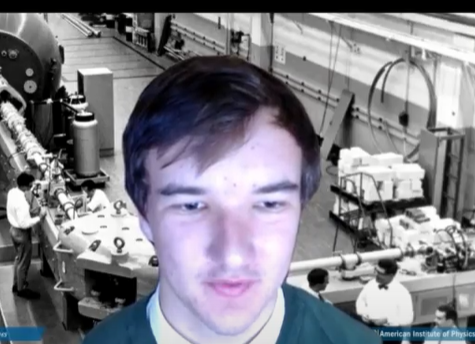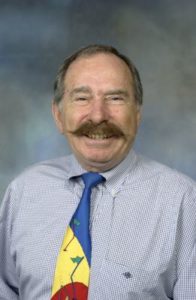Insights From Medical Imaging Professionals

The interviews were done by Hugo Currie as a year twelve high school student at the Riverina Anglican College in Wagga Wagga, Australia. He is passionate about physics and is now pursing a career in engineering and physics at the Australian National University. Below are a series of interviews that Hugo conducted with prominent physicists from around the world. Hugo is hopeful that other students with similar interests will be inspired from these conversations, and he thanks all of the physicists who gave of their time and wisdom in these interviews.
Interview with Professor Dale Bailey
 Professor Dale Bailey is a Professor of Medical Physics at the University of Sydney, Principal Medical Physicist at Royal North Shore Hospital, and Director of the Sydney Vital Northern Translational Cancer Research Centre. Professor Bailey is internationally renowned for his work in hybrid imaging technology, quantitative SPECT and theranostics. His profile can be found at https://www.sydney.edu.au/medicine-health/about/our-people/academic-staff/dale-bailey.html. Please enjoy Hugo’s interview with Professor Bailey below.
Professor Dale Bailey is a Professor of Medical Physics at the University of Sydney, Principal Medical Physicist at Royal North Shore Hospital, and Director of the Sydney Vital Northern Translational Cancer Research Centre. Professor Bailey is internationally renowned for his work in hybrid imaging technology, quantitative SPECT and theranostics. His profile can be found at https://www.sydney.edu.au/medicine-health/about/our-people/academic-staff/dale-bailey.html. Please enjoy Hugo’s interview with Professor Bailey below.
Interview with Professor Stewart Bushong
 Professor Stewart Bushong has been Professor and Section Chief of Radiologic Physics at Baylor College of Medicine in Houston Texas since 1976. He has been integral in the professional associations and licensure boards for Medical Physicists in Texas and the USA and holds medical physics license number 0001. He has numerous textbooks in MRI, CT, ultrasound and radiation protection. His Radiologic Science textbook is in its 12th edition and has been used globally as a textbook for university students since 1974. His books can be found at https://www.thriftbooks.com/a/stewart-c-bushong/226021/. Please enjoy Hugo’s interview with Professor Bushong below.
Professor Stewart Bushong has been Professor and Section Chief of Radiologic Physics at Baylor College of Medicine in Houston Texas since 1976. He has been integral in the professional associations and licensure boards for Medical Physicists in Texas and the USA and holds medical physics license number 0001. He has numerous textbooks in MRI, CT, ultrasound and radiation protection. His Radiologic Science textbook is in its 12th edition and has been used globally as a textbook for university students since 1974. His books can be found at https://www.thriftbooks.com/a/stewart-c-bushong/226021/. Please enjoy Hugo’s interview with Professor Bushong below.
Interview with Professor Simon Cherry
 Professor Simon Cherry completed his undergraduate Science and Medical Physics PhD in London, before moving to UCLA where he developed co-registration techniques between PET and MRI, and also developed technology for high-resolution marker PET for imaging small animals. He relocated to UC Davis where he started his own molecular imaging and biomedical engineering laboratory. He is a professor in both the biomedical engineering and radiology departments, he is the co-director of the explorer molecular imaging center, and he is a distinguished professor in the Cherry Lab for molecular imaging technology. Professor Cherry is responsible for developing the technology that allowed simultaneous PET MRI development, and he developed the first total body PET scanner called the Explorer which is revolutionizing clinical research in molecular imaging. He is widely published, including lead author on several influential text books and book chapters, and has a long list of prestigious awards. His profile is available at https://bme.ucdavis.edu/people/simon-cherry. Please enjoy Hugo’s interview with Professor Cherry below.
Professor Simon Cherry completed his undergraduate Science and Medical Physics PhD in London, before moving to UCLA where he developed co-registration techniques between PET and MRI, and also developed technology for high-resolution marker PET for imaging small animals. He relocated to UC Davis where he started his own molecular imaging and biomedical engineering laboratory. He is a professor in both the biomedical engineering and radiology departments, he is the co-director of the explorer molecular imaging center, and he is a distinguished professor in the Cherry Lab for molecular imaging technology. Professor Cherry is responsible for developing the technology that allowed simultaneous PET MRI development, and he developed the first total body PET scanner called the Explorer which is revolutionizing clinical research in molecular imaging. He is widely published, including lead author on several influential text books and book chapters, and has a long list of prestigious awards. His profile is available at https://bme.ucdavis.edu/people/simon-cherry. Please enjoy Hugo’s interview with Professor Cherry below.
Interview with Professor Ran Klein
 Professor Ran Klein is an imaging physicist at the Ottawa Hospital and University of Ottawa. He is also a professor in engineering and physics at Carleton University in Canada. Professor Klein has more than 100 journal publications for research in image quantitation and computer aided diagnosis. He has a degree in Computer Engineering, masters degree in Electrical Engineering, and a PhD in Medical Physics Applications. His profile can be found at http://www.ohri.ca/profile/RanKlein. Please enjoy Hugo’s interview with Professor Klein below.
Professor Ran Klein is an imaging physicist at the Ottawa Hospital and University of Ottawa. He is also a professor in engineering and physics at Carleton University in Canada. Professor Klein has more than 100 journal publications for research in image quantitation and computer aided diagnosis. He has a degree in Computer Engineering, masters degree in Electrical Engineering, and a PhD in Medical Physics Applications. His profile can be found at http://www.ohri.ca/profile/RanKlein. Please enjoy Hugo’s interview with Professor Klein below.
Interview with Professor Zdenka Kuncic
 Professor Zdenka Kuncic obtained a degree in Science with first class honors in Physics at the University of Syndey, followed by a PhD in Theoretical Astrophysics at the University of Cambridge. She is a Professor of Physics and a Fullbright future scholar at the University of Sydney where she leads an interdisciplinary research team working on projects that bridge physics, medicine, biology, neuroscience, and engineering to solve complex problems. Her profile can be found at https://www.sydney.edu.au/science/about/our-people/academic-staff/zdenka-kuncic.html. Please enjoy Hugo’s interview with Professor Kuncic below.
Professor Zdenka Kuncic obtained a degree in Science with first class honors in Physics at the University of Syndey, followed by a PhD in Theoretical Astrophysics at the University of Cambridge. She is a Professor of Physics and a Fullbright future scholar at the University of Sydney where she leads an interdisciplinary research team working on projects that bridge physics, medicine, biology, neuroscience, and engineering to solve complex problems. Her profile can be found at https://www.sydney.edu.au/science/about/our-people/academic-staff/zdenka-kuncic.html. Please enjoy Hugo’s interview with Professor Kuncic below.
Interview with Professor Steven Meikle

Prof Steven Meikle is a Professor of Medical Imaging Physics at the University of Sydney, Head of Imaging Physics at The Brain and Mind Research Institute, and Research Academic Director in the Faculty of Medicine and Health at the university of Sydney. He is a Fellow of the Australian Institute of Physics, a Senior Member of the IEEE, and an Honorary Professorial Fellow at the Centre for Medical Radiation Physics at the University of Wollongong. Professor Meikle is internationally recognised for his expertise in imaging physics and quantitative approaches, specifically in advanced imaging methods to quantitatively evaluate molecular mechanisms regulating brain function. His profile can be found at https://www.sydney.edu.au/medicine-health/about/our-people/academic-staff/steven-meikle.html. Please enjoy Hugo’s interview with Professor Meikle below.
Interview with Professor David Townsend
 Professor David Townsend worked as a particle physicist at CERN, before becoming a medical physicist. He was instrumental in developing the first positron emission tomography systems, and invented the PET CT system that combined PET imaging with CT imaging, TIME Magazine’s invention of the year in 2000. Professor Townsend received a long list of prestigious awards and invited lectureships, recognizing his extraordinary contribution to medical physics. He has worked as a medical physicist in Geneva University Hospital, the University of Pittsburgh, and the National University of Singapore. His profile can be found at https://hstalks.com/expert/2970/prof-david-townsend/. Please enjoy Hugo’s interview with Professor Townsend below.
Professor David Townsend worked as a particle physicist at CERN, before becoming a medical physicist. He was instrumental in developing the first positron emission tomography systems, and invented the PET CT system that combined PET imaging with CT imaging, TIME Magazine’s invention of the year in 2000. Professor Townsend received a long list of prestigious awards and invited lectureships, recognizing his extraordinary contribution to medical physics. He has worked as a medical physicist in Geneva University Hospital, the University of Pittsburgh, and the National University of Singapore. His profile can be found at https://hstalks.com/expert/2970/prof-david-townsend/. Please enjoy Hugo’s interview with Professor Townsend below.
Interview with Professor Howard Wiseman
 Professor Howard Wiseman is a theoretical quantum physicist, known for his work on quantum feedback control, quantum measurements, quantum information, and other fundamental issues in quantum mechanics. He has won prestigious awards, and is currently the Director of the Center for Quantum Dynamics at Griffith University in Brisbin. His profile can be found at https://experts.griffith.edu.au/18725-howard-wiseman. Please enjoy Hugo’s interview with Professor Wiseman below.
Professor Howard Wiseman is a theoretical quantum physicist, known for his work on quantum feedback control, quantum measurements, quantum information, and other fundamental issues in quantum mechanics. He has won prestigious awards, and is currently the Director of the Center for Quantum Dynamics at Griffith University in Brisbin. His profile can be found at https://experts.griffith.edu.au/18725-howard-wiseman. Please enjoy Hugo’s interview with Professor Wiseman below.



















